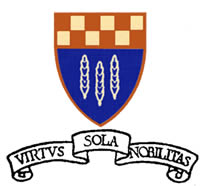


1600 Religious & Legal Background
1660 High Pavement Chapel (the Institution) founded
1662 Act of Uniformity
1692 High Pavement Chapel (the Building) founded – The 1st Chapel Building
1689 Toleration Act -
1697 Blasphemy Act -
1758 Schism within HP Chapel. Rival Chapel built at Halifax Place.
1774 George Walker FRS, an eminent Mathematician, becomes Chapel Minister.
1785 Schism Ends. George Walker instrumental in healing schism.
1785 Halifax Place Chapel now surplus to requirements.
1787 Income from rental of Halifax Place Chapel used to fund HP School.
1787 Vestry Meeting in Oct gave go ahead for founding of new School. Minutes indicate that school was intended for the children of the poor of this Society (suggesting that it was intended to be denominational at that time).
1788 HIGH PAVEMENT SCHOOL FOUNDED
1788 First Master: THOMAS WHEATCROFT (17yrs). Teaching conducted at his own home at the corner of Willoughby Street and Fisher Gate. He was by profession a ‘Steward’ (what today would be called a ‘Solicitor’) and continued that work whilst Headmaster.
1796 School now clearly “Non-
1798 George Walker FRS, leaves HP Chapel.
1802 High Pavement Chapel Congregation becomes Unitarian.
1799 Thomas Wheatcroft now living and teaching in St Mary’s Gate.
1805 Thomas Wheatcroft resigns as Headmaster.
1805 First Unitarian Chapel underwent substantial repairs & new Schoolrooms were constructed behind Chapel.
1805 1st SITE – HIGH PAVEMENT (1805-
1805 First dedicated School Buildings became available, built on cliff face behind Unitarian Chapel on High Pavement. Girls’ School was on the level of the Chapel with the Boys’ School below.
1805 New Master: GEORGE MILNES (7yrs), a Clockmaker. He continued with his trade whilst School Master.
1806 School has 44 Pupils (22 of each sex). 44
1812 New Master: JOHN MALBON (3yrs), a Tailor. He continued with his trade whilst School Master.
1813 The ‘Unitarian Relief Act (or Unitarian Toleration Bill)’ was passed – removed Unitarians from penalties under the Toleration Act (1689) & Blasphemy Act (1697).
1816 New Master: JOHN TAYLOR (44yrs). Recruited from a local private school -
1829 School no longer entirely a Charity school. 28 of 40 boys now paying fees.
1831 Nottingham Castle set on fire
1846 School Buildings substantially re-
1849 School has 130 Pupils (80 boys & 50 girls) 130
1850 Girls’ School became “British School” subject to Government Inspection.
1859 Infants Class began.
1861 New Headmaster: WILLIAM HUGH (44yrs).
1861 Boys’ School became “British School” subject to Government Inspection.
1869 Infants Class established as a separate Dept.
1871 Sgt George Vickers employed to drill the Boys in Castle grounds.
1873 1st High Pavement Chapel demolished to allow construction of new larger Chapel.
1876 New 2nd High Pavement Chapel opened.
1883 HP established Organised Science School. Now accepted as the Country’s 1st.
1888 High Pavement Centenary Dinner held on 26 Jan 1888.
1892 High Pavement School passed to Nottingham School Board – finally severing long connection (104 yrs) with the High Pavement Chapel.
1895 2nd SITE – STANLEY ROAD (1895-
1895 Schools moved to new purpose-
1905 New Headmaster: Mr E Francis (13yrs).
1914 WORLD WAR 1 Started:
1918 WORLD WAR 1 Ended:
1918 New Headmaster: Mr W C Edkins (2yrs).
1920 New Headmaster: Mr E P Adams (2yrs).
1921 New Headmaster: Dr H J Spenser (8yrs)
HJS invented the name “Pavior”.
Introduced Rugby, though some Soccer permitted to continue.
He developed the Boxing Club and founded the Boat Club.
He developed the “House System”.
He introduced the “self-
1929 New Headmaster: Mr G J R Potter (18yrs).
1931 HP Girls (and many mostly female staff) transferred to newly built Manning School -
1932 School Colours changed to Brown, Yellow & Blue (from previous Green & Red) and new School Badge introduced.
1932 School gains first 2 Oxbridge Scholarships -
1939 WORLD WAR 2 Began:
1945 WORLD WAR 2 Ended:
1947 New Headmaster: Mr H Davies (16yrs).
1955 3rd SITE – GAINSFORD CRESCENT (1955-
1955 School moved to new premises at Gainsford Crescent, Bestwood Estate (Sep 55).
1963 Headmaster Harry Davies resigned to take up new post at Nottingham University as Director of Education.
1963 New Headmaster: MAURICE BROWN (11yrs).
1972 Last Year with Intake of 1st year Grammar School Boys.
1973 Transition to 6th-
1974 Girls admitted to 6th-
1977 Last of Grammar School intake enter 6th-
1979 Transition to Mixed 6th-
1980 121st Nottingham (High Pavement) Scout Troop wound up.
1998 High Pavement 6th-
2002 3rd Site -
2002 4th SITE – CHAUCER STREET
2017 Nottingham College formed -
https://www.nottinghamcollege.ac.uk/study/sixth-